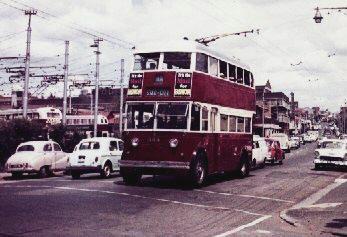
| Home Page | Index
| Links | South Africa |
Steve | Genealogy |
|Orthodox Church | Mission
| Family | Val | Penpals
|
|Russia
| Orthodox Faith
| Literary stuff
| Balkans
| Trolleybuses
|
 |
[ Back to Table of Contents | Back to top of page | Index of all pages ]
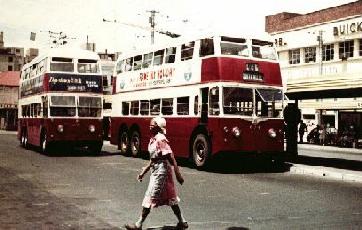 |
The system had electric trams from 1906 to 1961. Trolley buses were introduced in the 1930s, and reached their maximum extent in the 1960s and early 1970s. They were removed from service in the early 1980s after a few experiments with some new types of bus for an urban transport research project.
The experimental buses included the first single-decker trolleybuses to be tried in Johannesburg, but they were only inservice for a short time. There were single-decker oil buses, but at first they were only used for one-man operation in outlying suburbs, while services within the municipal area had two-man operated double deckers.
When the trams stopped, the bus routes were renumbered to the scheme above - starting with North at 12 o'clock, and going clockwise round the map from the centre of town. All routes ran from the centre to the suburbs, there was no through running, which was one of the reasons the bus service lost money then, and still loses it now - the buses don't go where people want to go. Apartheid also made it very expensive, but that's not an excuse any more.
So Routes 1 & 2 were north (and 79 was just west of them, and joined at a circle, which was also the terminus for 79A - Parktown North via Zoo Lake). Several routes had an A at the end - these were for buses that ran mainly in peak periods, and followed the same route, but did not go as far. The Parktown North circle was the bane of learner drivers, who usually spent a couple of days practising on it. Eventually it was replaced by an easier layout, which also had the advantage of getting the buses off the street.
Routes 10-20 were north east. 11 and 12 were diesel feeder buses, which ran from the Highlands North Terminus to Bramley and Lyndhurst respectively - the only buses that had transfer tickets.
Routes 44 to 50 were the southern suburbs, and were converted to trolley bus from diesel. Less frequent routes, like 45 (The Hill) and 48 (Linnmeyer) stayed diesel. The Forest Hill (49) routes had some experimental sections of semi-catenary overhead wires. They were suspended from the insulators by two short wires, about a foot long. I don't know if the experiment proved anything, but they were not extended to other parts of the system.
Routes 60, 66 and 67 went west, and 66 and 67 were among the last trolleybus routes to operate in the 1980s. .
 |
Then there were BUT Series II 6-wheelers, added to the fleet in about 1956, along with some AEC Mk V diesels. The bodies were all metal, and were a little wider than the older buses, but the seats were closer together, sith less leg room, so they were not as comfortable for passengers. The bodies were all built by Bus Bodies of Port Eleizabeth, with the exception of some of the Series I BUTs, which had rebuilt bodies by a Germiston firm, and were contemptuously called "bokwa" (goat cart) by the running staff. Conductors, especially, didn't like them, because they had to scrabble on the floor upstairs to change the destination blinds.
In 1959/60 there were some Alfa-Romeo/Ansaldo 6-wheelers, added, which took over 100 passengers, with compressed air power steering.
At the same time there were some Sunbeams, also big. They had hydraulic power steering, and there were some diesel Guys built on the same chassis at the same time. They had a horrible handbrake, which required several pulls of a ratchet, but which would let go everything at the touch of a button.
In the early 1980s there were a few experimental buses, used just before the system closed. They ran on the Hillbrow and Parkhurst routes, and possibly others. I have no more information about them.
I'm not a dedicated bus or train spotter, so I don't have the details about the fleet that such people would like - fleet numbers, technical specifications and the like. But if anyone does have that information, and would like to pass it on to me, I'll be happy to make it available here. Also, if anyone spots any inaccuracies, please let me know, so I can correct them.
The nicest ones to drive were the Sunbeam Series 3 four-wheelers. They ran mainly on the Homestead Park (60) and Mayfair (60A) routes, and also on Greenside (77). They were small, and only held 60 seated passengers. The Mayfair-Homestead Park route was short and very busy, so the conductor would not have time to collect the fares on a bigger bus. Greenside was longer, but a very quiet route, especially at night. They had a long power pedal that was easier to control than most of the others, and it had nine power notches. Late at night, when they did not have a heavy load, they could be quite frisky, and handled almost like a car.
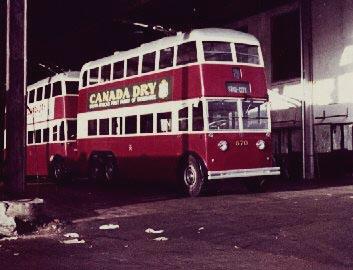 |
The Alfa-Romeo-Ansaldo and Sunbeam Series 4 buses were the biggest of the lot. They were introduced in 1959, and could take 110 seated passengers. In spite of having power steering, they were harder to drive. Unlike the older buses, they had the handbrake on the left rather than the right, and the Sunbeams needed 3-4 strokes with the ratchet before the handbrake took. As a result a lot of drivers took power frogs too fast, and the big Sunbeams suffered many dewirements. On the Alfa Romeos the driver was seated much lower, or the sides of the bus were higher, making it more difficult to see the traffic, and one had to be extra careful about cyclists.
[ Back to Table of Contents | Back to top of page | Index of all pages ]
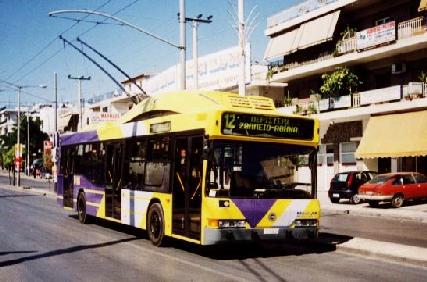
 In Athens the trolley bus service is run by ELPAP, which stands for Electrokinita Leoforia Periochis Athinon-Pireos. The trolleybus routes run through the centre of the city, and the diesel buses (run by a separate organisation) run from the centre to the outlying suburbs. The same tickets (bought at kiosks) may be used on both. Until recently all the trolley buses were made in Russia, and were the same as those used in Moscow. They were painted yellow, and were rather old. The fleet is now being modernised, however, probably in preparation for the 2004 Olympics. The new buses are from Neoplan, and are air-conditioned. They also have auxiliary diesel motors to get around obstacles along the route.
In Athens the trolley bus service is run by ELPAP, which stands for Electrokinita Leoforia Periochis Athinon-Pireos. The trolleybus routes run through the centre of the city, and the diesel buses (run by a separate organisation) run from the centre to the outlying suburbs. The same tickets (bought at kiosks) may be used on both. Until recently all the trolley buses were made in Russia, and were the same as those used in Moscow. They were painted yellow, and were rather old. The fleet is now being modernised, however, probably in preparation for the 2004 Olympics. The new buses are from Neoplan, and are air-conditioned. They also have auxiliary diesel motors to get around obstacles along the route.
[ Back to Table of Contents | Back to top of page | Index of all pages ]
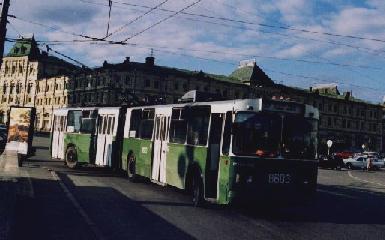 |
There seemed to be two main types - short four-wheelers, similar to the older ones in Athens, and the long articulared ones. That's about all I know of the composition of the fleet. One thing that interested me was that the trams had pantograph collectors, not trolleys, but they didn't seem to have any problems crossing the trolley bus wires.
[ Back to Table of Contents | Back to top of page | Index of all pages ]
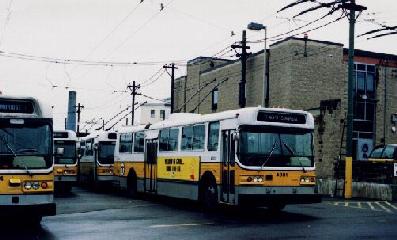 |
The gates to the depot were locked, and there was no activity, so I assumed that the bus service operated on weekdays only. So I never did have a ride on a Cambridge trolley bus. Perhaps one day I'll get back there, and might have a second chance.
[ Back to Table of Contents | Back to top of page | Index of all pages ]
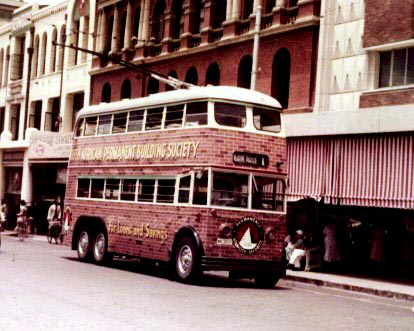 |
That hope was never realised. We moved away when I was nearly 7, and only returned for occasional visits. Apartheid came, and the suburbs around Mayville were ethnically cleansed, and the trolley bus route was shortened to end at Tollgate, at the top of Berea Road, and eventually they were taken off in 1968.
When we lived in Westville, the Durban Corporation fleet was painted grey, but it later became multicoloured. Many buses were painted by the advertisers, as the picture shows. "Non-Europeans only" buses were painted green. During the apartheid years the trolley buses had some seats reserved for "Europeans" and others for "non-Euopeans", and there were coloured lights on the front of the bus to tell you which they were. On the bus in the picture the light can be seen just next to the destrination blind. The Durban trolley buses also had racks on the back to hold fishing rods. Two routes ran down West Street to the beach, where one went along the Marine Parade to the North Beach, while the other went past the South Beach to Addington Hospital, On those routes one usually saw three or four fishing rods in the racks.
[ Back to Table of Contents | Back to top of page | Index of all pages ]

 This trolley bus web ring site is owned by
This trolley bus web ring site is owned by Steve Hayes. Want to join the trolley bus web ring? |
|---|
| [Skip Prev] [Prev] [Next] [Skip Next] [Random] [Next 5] [List Sites] |
[ Back to Table of Contents | Back to top of page | Index of all pages ]
 to this page since 5 July 2000
to this page since 5 July 2000
While you are here, why not visit some of our other pages?
Click on the links below
| Home Page |
Index |
BBS Web |
World Chat |
Literary stuff |
South Africa |
| BBS page |
Trolleybus |
Orthodox Church |
Russia |
Witches |
Steve |
| Theology |
Peacemakers |
Balkan Spring |
Youth discussions |
Started: 4 July 2000
Updated: 29 October 2007